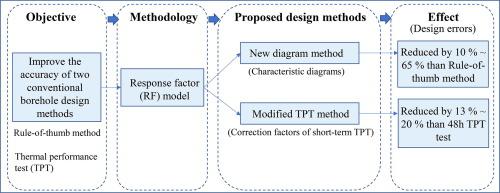Energy and Buildings ( IF 6.7 ) Pub Date : 2021-02-27 , DOI: 10.1016/j.enbuild.2021.110848 Tian You , Xianting Li , Hongxing Yang

|
For ground source heat pumps with boreholes, the rule-of-thumb and thermal performance test (TPT) methods are commonly adopted for borehole design but suffer from inaccuracy. The response factor model can calculate the time-varying soil heat transfer of boreholes fast and accurately. Based on the response factor model, the characteristic diagrams of borehole heat transfer are summarized to show the influential laws of different factors (borehole inlet temperature, velocity of fluid inside the pipe, initial soil temperature, soil thermophysical properties, and operation time). The characteristic diagrams can be used as a new design method that improves the accuracy of the rule-of-thumb method by considering different influential factors and avoiding the subjective errors of designers. For different soils, the borehole design errors of the new diagram method are −5% to 10%, which are much less than the errors (−15% to 72%) of the conventional rule-of-thumb method. In addition, a modification to the TPT method is also proposed using the response factor model. The borehole design errors of the conventional TPT method (48 h testing) can be reduced by 13%–20% using the derived correction factors. The proposed modification methods contribute to more reasonable borehole design, improved heating reliability as well as increased energy efficiency.
中文翻译:

基于新型响应因子模型的井壁换热器常规设计方法的修改
对于带有钻孔的地源热泵,通常采用经验法则和热性能测试(TPT)方法进行钻孔设计,但会出现误差。响应因子模型可以快速,准确地计算出随时间变化的井眼土壤传热。基于响应因子模型,总结了井眼传热的特征图,以显示不同因素(井孔入口温度,管道内流体的速度,初始土壤温度,土壤热物理性质和运行时间)的影响规律。特性图可以作为一种新的设计方法,通过考虑不同的影响因素并避免设计者的主观错误来提高经验法则的准确性。对于不同的土壤,新图表法的井眼设计误差为-5%至10%,远小于传统的经验法则方法的误差(−15%至72%)。此外,还提出了使用响应因子模型对TPT方法进行修改的方法。使用推导的校正系数,常规TPT方法(48小时测试)的井眼设计误差可减少13%–20%。提出的修改方法有助于更合理的井眼设计,提高的加热可靠性以及提高的能源效率。使用推导的校正系数,常规TPT方法(48小时测试)的井眼设计误差可减少13%–20%。提出的修改方法有助于更合理的井眼设计,提高的加热可靠性以及提高的能源效率。使用推导的校正系数,常规TPT方法(48小时测试)的井眼设计误差可减少13%–20%。提出的修改方法有助于更合理的井眼设计,提高的加热可靠性以及提高的能源效率。


























 京公网安备 11010802027423号
京公网安备 11010802027423号